
Schafbergbahn
Cog-wheel railway with the gauge 1000 mm goes out from St.Wolfgang recumbent near Wolfgang lake and ends below
mountain hotel on Schafberg. The length of the rail is 5,86 km with Abt system rack-rail on whole route. Average
rise of the rail is 205 per mille, maximum rise 255 per mille (the most of all three Austrian cog-wheel railway).
The station on the top lies in 1732 above sea-level, general camber amounts 1188 m.
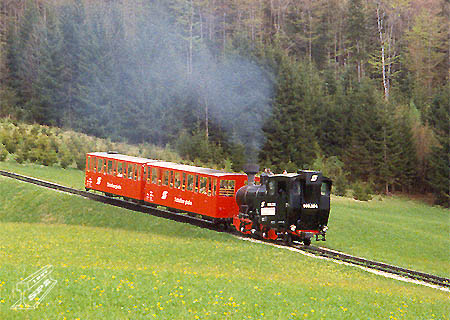 |
| 999.204 rises under St.Wolgang (photo 1st May 1998) |
Licence to construction of cog-wheel railway was signed on January 1890 and on April 1892 construction begin, with
support of Oberösterreich region and of Salzburg region through their frontier the rail goes, and also with the help
of villages Ischl and St.Wolfgang. Firm Stern & Hafferl led this construction for SKGLB (Salzkammergut Lokalbahn
- Local Railway of Salzkammergut) and after winter interval in the end of July 1893 this firm finished, so that 1st
August 1893 was normal tourist service initiated.
The transport to Schafberg was from the beginning very wanted and that is why SKGLB next year bought not only further
wagons and locomotives but also mountain hotel on Schafberg and shipping on Wolfgang lake, which ensured the connection
with narrow-gauge railway of SKGLB on the second lake bank.
During the World War II turism defoliated and public service of the cog-wheel railway was stopped in 1919. For further
six years this cog-wheel railway was in administration of BBÖ. The SKGLB sold the rail in 1931, also hotel and
shipping to Austrian Verkehrsbüro and BBÖ ensured the rail for them again. The tourists' interest on cog-wheel railway
declined.The World War II meant transfer of the line below Deutsche Reichsbahn and the service was stopped in 1941.
After the war ÖBB (Austrian Railways) assumed the route and the interest on tourism rises again and with smaller swing
persists into nowadays.
The transport on the rail started with four steam locomotives Krauss Linz, delivered in 1893, then followed with two
others one year later. Five almost coincident locomotive get in 1896 - 1900 on Schneeberg cog-wheel railway.
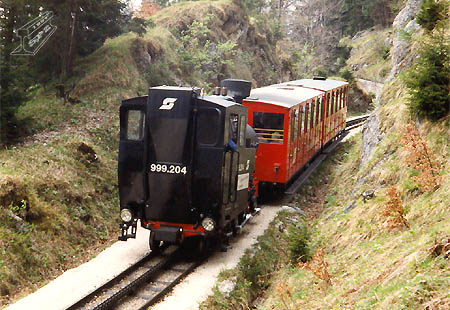 |
| 999.204 under St.Wolgang (photo 1. 5. 1998) |
There was delivered six carriages too, because one locomotive could push up only one carriage. Five carriages were
of four-axles with sixty places for passengers and one carriage was of two-axles at first for ten passengers, later
modified for transportation of twenty people.
Gradually locomotives were modernised. At first the locomotive linkage valves were changed for Pop's ones and steam
dome was increased as an improvised steam drier. After the World War II there was installed electric lighting and
original chimneys and tuyere were exchanged by new system Giesl in 1954. Then the security automatic air-pressure
brake (pressure air was in pressure bottle installed on the rear tribe of locomotive).
The steam dominion ends in 1964, when there was two motor coaches with hydraulic transmission of power by the SGP
locomotive company delivered. For the first time the motor coach went to rail on 25th of May 1964. These motor coaches
were checking on Schneeberg rail, but after tests it returned back to home depot near Wolfgang lake.
Motor coaches were displaced on carry train together with steam locomotives. There was needed less steam locomotive
for the same number of transported trains, and that is why locomotive 999.101 went away in 1970 invariably on
Schneebergbahn.
In eightieth's ÖBB began ruminate over savings on their rail. These endeavour contained also Schafberg railway, where
rolling stock had to be modernised. ÖBB fortunately knew steam engine magic on cog-wheel railway and that is why ÖBB
ordered 4 new steam locomotives heating with light heating oil from Swiss locomotive works SLM in Winterthur. The
first - 999.201 - was in St.Wolfgangu in 1993 and before the sending here it get through test on Schneeberg cog-wheel
railway. The second steam loco 999.202 was delivered 26th January 1996. On the contrary the old 999.105 was removed
into Attnang-Puchheim for repairing. After repairing the loco should be set in transport museum in Vienna. Engines
999.203 and 999.204 made in 1995 came on March 1996. Their official presentation was realised in the beginning of
May 1996. In comparison with original ones these locomotives can push on track two wagons at once.
The carriage stock were modernised too. To original ones arrived the couple of new green carriages made in 1993 in
firm Bombardier-Wien and six new replicas of Schneeberg railway carriages made in 1995 in St. Pölten. Wagons have
metal body with wooden seats, antifriction bearing, coiled spring and spoke wheels. They are in red paint with notice
"Schafbergbahn" and with logo "ÖBB". They goes in couple.
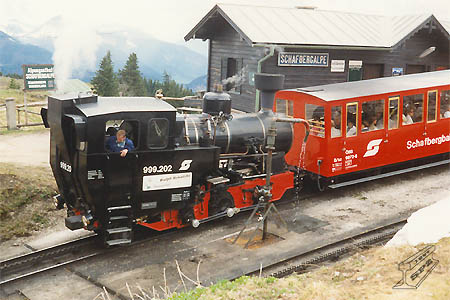 |
| 999.202 in station Schafbergalpe (photo 1. 5. 1998) |
The arrival of new steam locomotive meant the shelve of the original loco from service. Their fate is not fortunately
closed and locomotives are all the time on track in chief season per order.
In Wolfgang depot there are two motor railcars 5099.001 and 002, four "krauss" 999.102-104, 106 and four locomotives
SLM 999.201-204. Steam locomotives 999.1 manage the way to the top in 60 minutes inclusive tease waters in turnout
Dorneralpe and in Schafbergalpe station, they go down in 47 minutes. During tourist season the tourist interest was
so big that for removal of all traveller it was necessary fit out several train below the same numbers at once. Motor
railcar manage ride up in 39 minutes, down then in 40 minutes, similar to locomotives of class 999.2.
In 1986 there was built new station building in the top station. On the track there are two tunnels, one closely
before station Schafbergalpe and second before Schafbergspitze.
The service on the rail begins 1st May in chief season from 1st July to the end of August is here the possibility to
order some ride with original locomotive of class 999.1. The rides end on October and are stopped over the whole
winter.
Text & photo by Daniel Brabenec
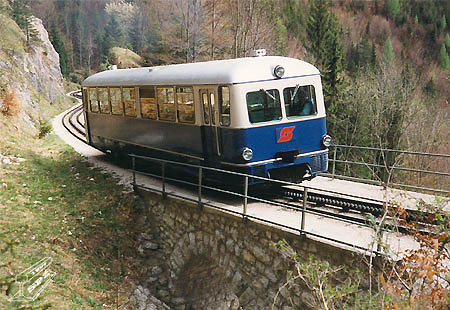 |
| 5099.002 za St. Wolgangem (1. 5. 1998). |
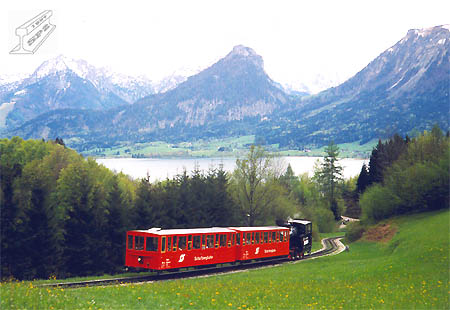 |
| 999.202 za St. Wolgangem (1. 5. 1998). |
| Map of railway Literature |